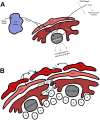Probing the enigma: unraveling glial cell biology in invertebrates
- PMID: 23896311
- PMCID: PMC3830651
- DOI: 10.1016/j.conb.2013.07.002
Probing the enigma: unraveling glial cell biology in invertebrates
Abstract
Despite their predominance in the nervous system, the precise ways in which glial cells develop and contribute to overall neural function remain poorly defined in any organism. Investigations in simple model organisms have identified remarkable morphological, molecular, and functional similarities between invertebrate and vertebrate glial subtypes. Invertebrates like Drosophila and Caenorhabditis elegans offer an abundance of tools for in vivo genetic manipulation of single cells or whole populations of glia, ease of access to neural tissues throughout development, and the opportunity for forward genetic analysis of fundamental aspects of glial cell biology. These features suggest that invertebrate model systems have high potential for vastly improving the understanding of glial biology. This review highlights recent work in Drosophila and other invertebrates that reveal new insights into basic mechanisms involved in glial development.
Copyright © 2013 Elsevier Ltd. All rights reserved.
Figures


Similar articles
-
Glial cell biology in Drosophila and vertebrates.Trends Neurosci. 2006 Feb;29(2):82-90. doi: 10.1016/j.tins.2005.12.002. Epub 2006 Jan 10. Trends Neurosci. 2006. PMID: 16377000 Review.
-
Radial Glia in Echinoderms.Dev Neurobiol. 2019 May;79(5):396-405. doi: 10.1002/dneu.22659. Epub 2018 Dec 14. Dev Neurobiol. 2019. PMID: 30548565 Free PMC article. Review.
-
Molecular profiling of invertebrate glia.Glia. 2025 Mar;73(3):632-656. doi: 10.1002/glia.24623. Epub 2024 Oct 16. Glia. 2025. PMID: 39415317 Free PMC article. Review.
-
Analysis of glial cell development and function in Drosophila.Cold Spring Harb Protoc. 2012 Jan 1;2012(1):1-17. doi: 10.1101/pdb.top067587. Cold Spring Harb Protoc. 2012. PMID: 22194269 Free PMC article. Review.
-
Glial cell progenitors in the Drosophila embryo.Glia. 2015 Aug;63(8):1291-302. doi: 10.1002/glia.22820. Epub 2015 Mar 16. Glia. 2015. PMID: 25779863 Review.
Cited by
-
Regulation of neuronal axon specification by glia-neuron gap junctions in C. elegans.Elife. 2016 Oct 21;5:e19510. doi: 10.7554/eLife.19510. Elife. 2016. PMID: 27767956 Free PMC article.
-
A Drosophila glial cell atlas reveals a mismatch between transcriptional and morphological diversity.PLoS Biol. 2023 Oct 20;21(10):e3002328. doi: 10.1371/journal.pbio.3002328. eCollection 2023 Oct. PLoS Biol. 2023. PMID: 37862379 Free PMC article.
-
Glial cells in neuronal development: recent advances and insights from Drosophila melanogaster.Neurosci Bull. 2014 Aug;30(4):584-94. doi: 10.1007/s12264-014-1448-2. Neurosci Bull. 2014. PMID: 25015062 Free PMC article. Review.
-
Wrapping Glial Morphogenesis and Signaling Control the Timing and Pattern of Neuronal Differentiation in the Drosophila Lamina.J Exp Neurosci. 2018 Mar 4;12:1179069518759294. doi: 10.1177/1179069518759294. eCollection 2018. J Exp Neurosci. 2018. PMID: 29531474 Free PMC article.
-
Loss of dihydroceramide desaturase drives neurodegeneration by disrupting endoplasmic reticulum and lipid droplet homeostasis in glial cells.Elife. 2025 Aug 27;13:RP99344. doi: 10.7554/eLife.99344. Elife. 2025. PMID: 40864161 Free PMC article.
References
-
- Buchanan RL, Benzer S. Defective glia in the Drosophila brain degeneration mutant drop-dead. Neuron. 1993;10:839–850. - PubMed
-
- Hidalgo A, Booth GE. Glia dictate pioneer axon trajectories in the Drosophila embryonic CNS. Development. 2000;127:393–402. - PubMed
-
- Stork T, Thomas S, Rodrigues F, Silies M, Naffin E, Wenderdel S, Klambt C. Drosophila Neurexin IV stabilizes neuron-glia interactions at the CNS midline by binding to Wrapper. Development. 2009;136:1251–1261. - PubMed
Publication types
MeSH terms
Grants and funding
LinkOut - more resources
Full Text Sources
Other Literature Sources
Molecular Biology Databases
Miscellaneous

